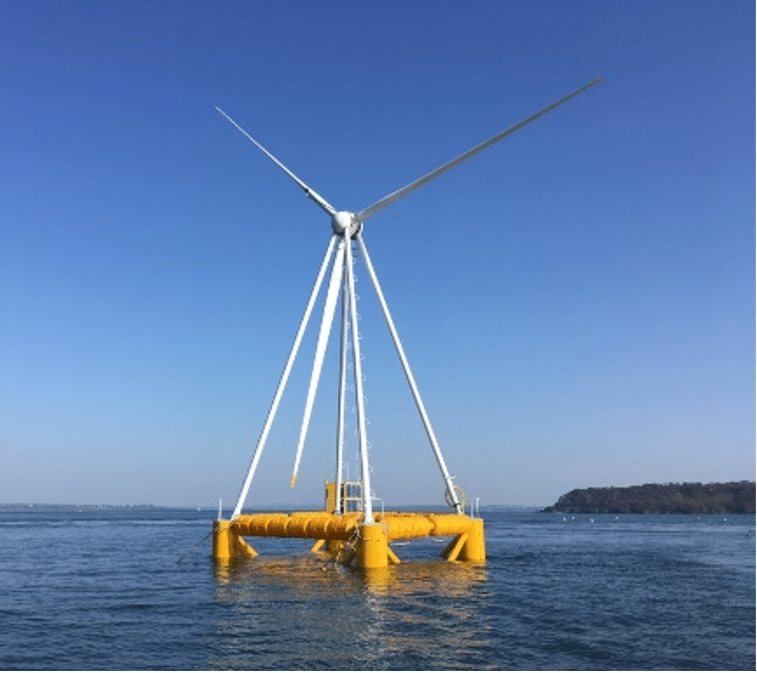
Background
The patented floating wind turbine platform Eolink is a technological breakthrough. Four arms replace the classic single mast supporting the turbine. This change allows for a better distribution of structural constraints and thus enhances fatigue resistance., and offers a better distribution of forces in a more rigid structure which is not subject to vibratory resonance The structure can be used with turbines up to 20 MW.
THE EOLINK CONCEPT
The Eolink concept allows for a 20% electricity cost reduction thanks to :
- a 30% lighter structure thanks to a better distribution of constraints,
- a 10% increase of electrical power production thanks to a greater distance between the mast and the blades,
- an easier onsite implementation allowed by a unprecedented towing speed and a quick connexion system
- A simple and automatable industrialisation alike modular construction of merchant ships,
The platform is anchored at a unique point (turret). In order to face the wind the structure moves around its anchor point as used in the oil industry for the mooring of storage vessels.
The platform is anchored at a unique point (turret). In order to face the wind the structure moves around its anchor point as in the oil industry for the mooring of storage vessels.
« Installation and maintenance operations are therefore reduced » points out Marc Guyot, the structure’s creator. Unlike other floating wind turbines the installation of the mooring lines and the the wind turbine are decoupled.
The currently developed wind turbine has the following characteristics:
- Power: 12 MW
- Rotor diameter: 200 m
- Nacelle: 120 m height above sea level ; a mass lower than 700 tonnes ;
- Semi-submersible floater made off steel or concrete; length: 66 m; width: 58 m.
Timeline :
2013: Eolink concept is patented
2015: creation of the Eolink company
2016: The 1:50 scale wind turbine is tested in a test tank. Results show that the structure should allow for a 25% reduction in the LCOE. The prototype endured harsh environmental conditions with wind blowing up to 9 m/s and a maximal 90° gap between wind and waves direction.
2018: Eolink receives a one million funding for its 1 :10 scale prototype. It is installed in April on the Ifremer test site in Sainte-Anne-du-Portzic. The marine and meteorological instrumentation is completed with constraints and deformation sensors implemented by Eolink on the structure.
Thanks to this prototype, Eolink gathered valuable information about the floating wind turbine behaviour, such as:
- Power output measurement according to the wind speed and the related floater tilt.
- Recording of the structure motions and anchor tensions in a stormy weather with winds and waves equivalent at scale 1 of respectively 15m (max height) and 250 km/h.
- Evidence that the wind turbine can face the wind by turning around its unique anchor point (turret).
2020: The start-up hopes to reach a levelized cost of energy of 35€/MWh by 2030 and pursues its development with the conception of a 5 MW prototype.
The 5 MW prototype is equivalent to a 12 MW floating wind turbine at a 3/4 scale. The steel floater has a 50 meters side. A classic wind turbine is used, for which the rotor was simply opened on its free face to insert a mechanical link between the hub and two of the structure masts. The EOLINK concept can indeed combine already existing technologies available on the market and easily integrate itself in its industrial environment.
Outlook and development plan
2021: The first project’s phase consists in testing the anchor buoy around which the wind turbine will turn. The anchors and the buoy will be installed at the SEM-REV test site to conduct mechanical and electrical tests in real environment. At the same time, the floater will be constructed at a shipyard.
2022: The 5 MW wind turbine will be towed on the SEM-REV test site for a power test. By increasing gradually its power production, it will reach a nominal power of 5 MW, producing around 14 GWh per year by 2023. During at least 3 years, the wind turbine will have to produce electricity in a wide range of metocean conditions to enable constraints measurements in the structure.
This power production from the prototype will partly pay back the investments costs, while the structural efforts monitoring will validate the conception of the 12,15 and 20 MW turbines that will be available for commercial French wind farms in 2028.
2024: Creation of a 40 MW pilot farm. With the knowledge gathered for the pre-commercial 5 MW wind turbine, Eolink aims for greater capacity from 10 to 13 MW. Its experience in construction and operation of the 5 MW wind turbine will be enough to launch those new turbines in 2023. The two options are adapted to extreme conditions and are therefore compatible with most sites. This pilot wind farm could supply a small electrical grid like one of a small island.
2026: The new Eolink wind turbine will be available with a LCOE from 50 to 70 €/MWh
2027: 250 MW wind farm project made of 17 15MW turbines using a generator specially developed and a 260 meter of rotor diameter. Using longer blades is possible thanks to the long distance between the blades and the masts on the Eolink structure. The generator located at 160m above water weights around 1 000 tons.
2030: The objective is to have a total industrial production of 1 GW/year with 67 15MW wind turbines and a goal LCOE of 35€/MWh.

